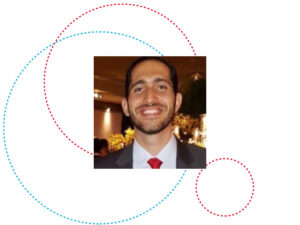Radar signal processing has the potential to simplify many aspects of our daily life. One such aspect that doctoral researcher, Gabriel Beltrao, from the University of Luxembourg’s Interdisciplinary Centre for Security, Reliability and Trust (SnT), is exploring is how they can be used to remove wires and adhesives used to monitor patients in hospitals. Using new signal-processing techniques, his doctoral studies within SnT’s Signal Processing in Radar and Communications (SPARC) research group has been focusing on enabling the use of radar devices to monitor vital signs. In 2022, he was notably a finalist in the European Signal Processing Conference’s (EUSIPCO) 3-Minute Thesis Competition, where he explained the significance of his research to a non-specialist audience. We spoke to him to dive deeper into his research experience over the last four years.
Why is this topic crucial to be addressing now?
The assessment of vital signs is essential for high-quality care. Vital sign information provides valuable insight into a patient’s condition, including how they are responding to medical treatment and, more importantly, whether they are deteriorating. They play a crucial role in the early detection of adverse events. However, conventional contact-based devices using adhesives and wires are inappropriate for long-term continuous monitoring. Besides mobility restrictions and stress, they can cause discomfort, epidermal damage, and even lead to pressure necrosis. This is especially important for specific groups of patients such as neonates, infants, elderly, and burned patients.
In addition, the challenge of an aging population worldwide is pushing toward novel healthcare solutions, evolving to a more person-centric approach where patients can be remotely observed anywhere. This can only be achieved using contactless devices.
How do you think your research results could be applied in the real-world?
Actually, this is happening already. We have a partnership with the Department of General Pediatrics and Neonatology from the Saarland University Medical School in Germany, where our radar solution was tested for monitoring the respiration of premature babies in the Neonatal Intensive Care Unit (NICU). You can find the initial results in our paper, which was published in Nature Scientific Reports. Now we are moving to a larger trial, where we will also try to monitor the baby’s heart rate and consider even more scenarios common to the NICU daily routine.
Besides directly improving the quality of life of patients in critical care, the capability of monitoring vital signs in a contactless way enables ubiquitous monitoring. This possibility of being everywhere gives rise to several consumer applications. For instance, it can be used in the automotive industry, psychology, security, and in sports. And of course, it can also be used at home for elderly and baby monitoring. Recently, we also got relevant results monitoring the breathing and heart rate of adults while working in an office environment. You can see the results of this here.
Why did you choose this subject?
I was very lucky to have an industrial partner on my side during the entirety of my doctoral studies. So the choice of this subject was a joint decision, in which they gave me a few promising topics they were interested in and I selected this one. From my side, this choice was very easy. Prior to joining SnT I was working in the industry for a long time, mainly designing radars for military applications. At that point, I couldn’t talk about my work to anyone due to confidentiality and, most of the time, it was too complex or intangible for many to understand anyway. On the other side, monitoring vital signs is something that people understand immediately. Not only what we are doing, but also how important it is. Now I can talk to everyone about my work, and I am very happy that people understand and appreciate it. And, apart from that, the opportunity of doing something to improve the quality of life of these small babies in the NICU is by far the most rewarding thing I ever did in my life.
What do you think comes next for this research subject?
I believe we are now moving from a research-based setting to a more practical and close-to-market validation. The intense research and mass production from the automotive industry is driving radar costs down, which is fundamental for widespread adoption. On the technical side, performance is improving, becoming more robust and closer to the current devices. There are still interesting challenges to address, most of them related to dynamic scenarios where the monitored subjects could be moving freely. Finally, the first products are starting to appear, and new questions will arise soon, including regulation, privacy aspects, and ethics.
Now that your Ph.D. is complete what does your future hold?
Right now, I am leaving academia and getting back into the industry as a signal processing engineer in a Luxembourg-based company. Among other responsibilities, I expect to keep working on this topic, going deeper into this technology, and moving a bit closer to the practical deployment of a contactless radar-based solution for monitoring vital signs.
Gabriel’s Ph.D. studies have concluded with a successful defence, which will took place on 20 February. To learn more, watch Gabriel’s 3-minute thesis presentation here, and see the radar device used in practice here.
